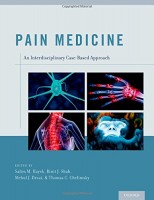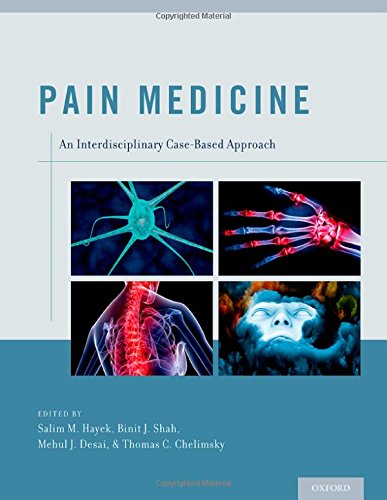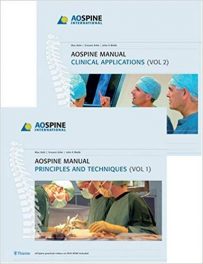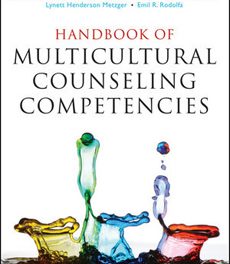 Editors: Salim M, Hayek, MD; Binit J. Shah, MD; Mehul J. Desai, MD; and Thomas C. Chelimsky, MD
Editors: Salim M, Hayek, MD; Binit J. Shah, MD; Mehul J. Desai, MD; and Thomas C. Chelimsky, MD
Publisher: Oxford University Press – 429 pages
Book Review by: Nano Khilnani
In the past, when patients were found to have pain that was not easily diagnosable or treatable by a single doctor, several specialists got involved in the pain discovery and treatment effort, such as an anesthesiologist, a physical therapist, a psychiatrist, a psychologist, a surgeon, and others.
That became expensive and oftentimes, medical insurance companies would not cover that expense, denying coverage. As a result, the specialists involved in treating pain, especially in complex cases of pain where there were multiple causes, began receiving additional specialized education and training.
So today, for example, an anesthesiologist must gain sufficient skills in neurology to care for patients with headaches, and a neurologist must acquire knowledge and experience in performing a neural blockade to provide treatments that patients will need.
Seventy-two specialists in fields relating to pain management (mostly physicians) from all over the United States, as well as four other countries – Belgium, Canada, the Netherlands, and Switzerland – wrote the 25 chapters of this book.
The content in the chapters is laid out mainly in the form of questions in headings, and answers to them in text that follow. For example in chapter 1, Small Fiber Neuropathy (written by Drs. Kamal Chemali, Salim Hayek, and Thomas C. Chelimsky), four questions are presented at the beginning, and then each question is answered through the length of the chapter.
Here is the typical format you will find in each chapter:
- Case presentation – a text box that briefly describes the problem of the patient. In this instance, it is a burning sensation in the foot, up to the ankle, of a 48-year-old man.
- Questions – a number of questions are asked at the beginning of the chapter. In this chapter, all the questions relate to small fiber neuropathy (SFN).
- Answers – to each question in the form of detailed discussions, interspersed with highlighted boxes that point out to findings obtained from examinations, etc.
- Practical Checklist, or a Conclusion – these are means to help you remember key points.
- References – a list of books and other sources of information on the chapter subject. These lists are sometimes long; for example, first chapter lists 91 sources for further study.
The 72 contributors of the material for this book, including the editors named above, discuss six basic types of pain and disorders that relate to (that are the source of, or result in) pain, as delineated in the six sections identified in the book’s contents pages:
- Neuropathic Pain
- Small Fiber Neuropathy
- Postherpetic Neuralgia
- Trigeminal Neuralgia and Other Facial Pain Conditions
- Carpal Tunnel Syndrome
- Muscle, Tendon, and Joint Pain
- Myofascial Pain Syndrome
- Pain of Rheumatological Disease
- Tendinopathies
- Spine and Related Disorders
- Discogenic Pain
- Lumbar Facet Pain
- Sacroiliac Joint Pain
- Lumbar Spinal Stenosis
- Lumbar Disc Replacement
- Post Laminectomy Syndrome
- Piriformis Syndrome
- Whiplash: Associated Disorder and Cervical Facet Pain
- Cervical Radicular Pain
- Thoracic Back Pain
- Visceral Pain
- Pain from Chronic Pancreatitis
- Chronic Pelvic Pain
- Chronic Refractory Angina
- Persistent Postsurgical Pain
- Postsurgical Thoracic Pain
- Post-Herniorrhaphy Pain
- Cancer-Related Pain
- Palliative Cancer Pain
- Headache
- Complex Regional Pain Syndrome (CRPS)
The discussions, in the form of answers to questions laid out at the beginning of each chapter, are typically quite lengthy and detailed.
In addition to this, you will find long lists of references at the end of each chapter, to enable you the student or practitioner, to learn more about the topic you’re interested in. For example, at the end of chapter 2, Postherpetic Neuralgia, you will find a References section that lists 239 books and other information sources!
The authors of this chapter – Drs. Srinivasa N. Raja, Renen Schecter, and Raimy Amsaha – answer 11 questions relating to postherpetic neuralgia (PHN) they pose in the beginning. In the Case Presentation, they write the symptoms found when a 78-year-old man is admitted into the hospital.
He has intense pain in the left side of his chest, and undergoes a cardiac checkup and monitoring. After 24 hours, the physicians note a vesicular rash over the T5-6 dermatome on the left. This pain is reported as burning that is constant and severe. The pain is not relieved by acetaminophen and non-steroidal anti-inflammatory drugs (NSAIDs).
Further diagnosis reveals he has a herpes zoster (HZ) infection. This was relieved with oral oxycodone 5 mg three times a day, with modest analgesia reported. He was then referred to the Interdisciplinary Pain Medicine Clinic, which found that his past medical history was significant for hypertension.
They found further that the 198 lb, 6-foot-tall man had allodyna over the left side of the chest wall, as well as decreased sensation to light touch in the T5 and T6 dermatomes.
The editors of this book recognized, as doctors who have been helping their patients relieve various kinds of pain, that successful pain treatment requires a variety of specialized knowledge and skills possessed by medical specialists in different fields. They realized that a multi-disciplinary approach to pain management is the most effective one. This book fills that need very well.
The novel case approach they’ve used in presenting and organizing the materials for this book – questions, answers, discussions – is also a smart move.
Salim M. Hayek, MD is Professor of Anesthesiology at Case Western Reserve University; and Chief of the Division of Pain Medicine at University Hospital of Cleveland in Cleveland, Ohio.
Binit J. Shah, MD is Director of the Intensive Care Unit at Ohio Hospital for Psychiatry in Columbus, Ohio.
Mehul J. Desai, MD is Director of Spine, Pain Medicine & Research at Metro Orthopedic and Sports Therapy in Silver Spring, Maryland.
Thomas C. Chelimsky, MD is Professor of Neurology at Medical College of Wisconsin in Milwaukee, Wisconsin.







